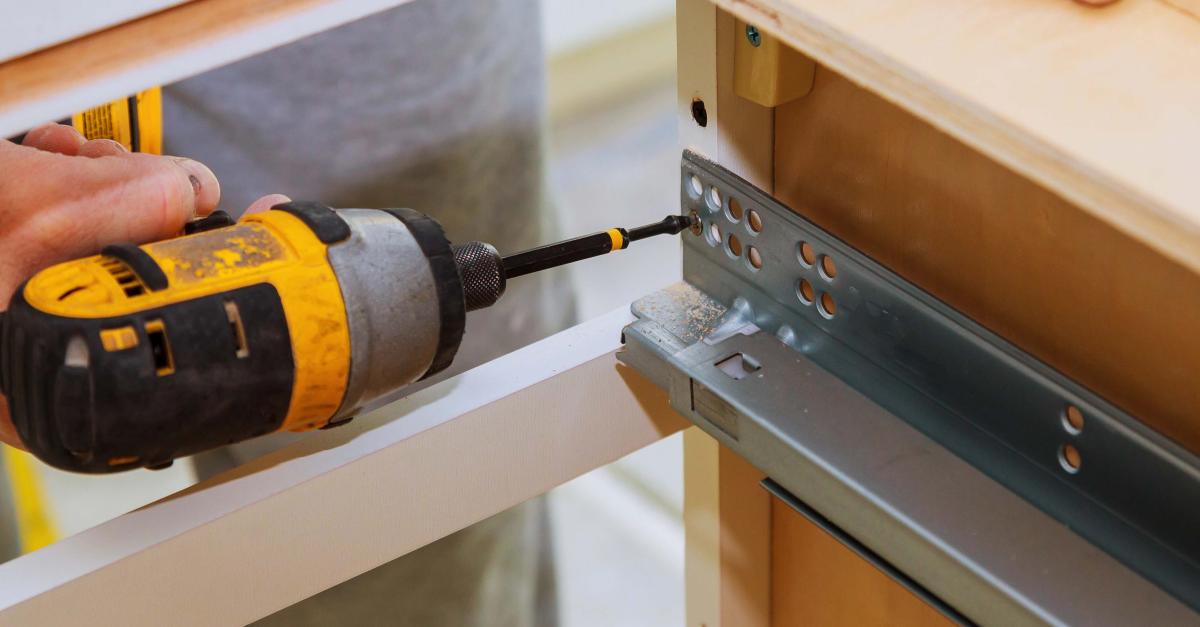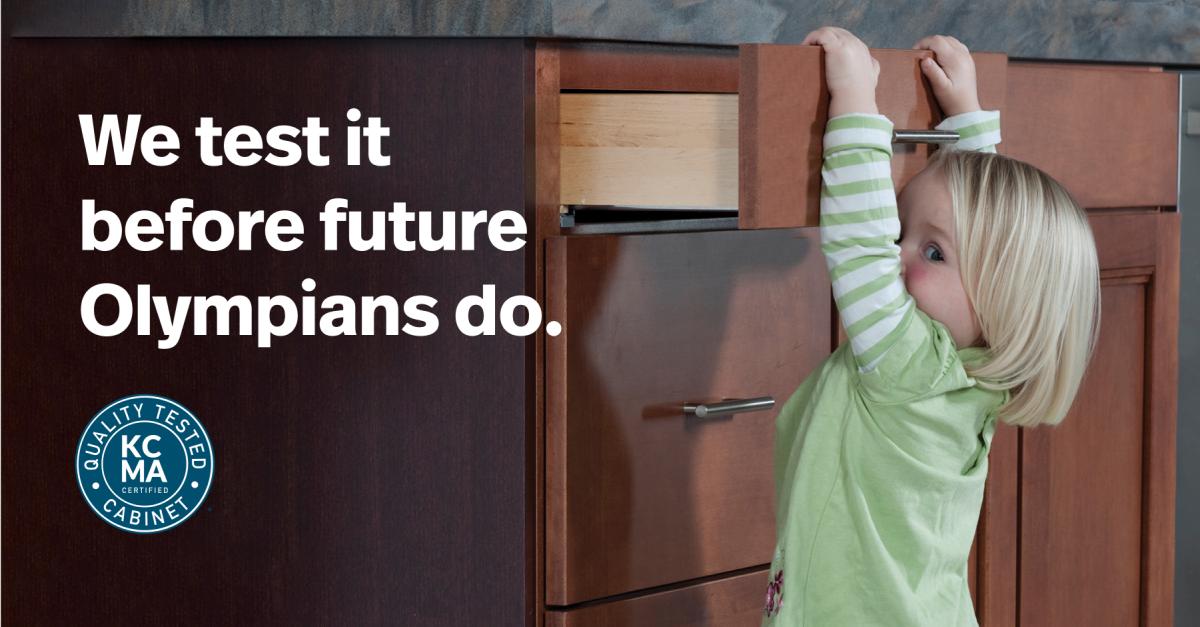by Larry Adams larry.adams@woodworkingnetwork.com
Weights, hundreds of pounds of weights, are piled on them to the point of collapse. Pound after pound is added, slowly, in a seemingly never-ending pile, and with each weight the strain grows worse, harder to withstand. They undergo other tortuous challenges. Joints strained to the point of popping as they are weighted and forced to do repetitive motions, thousands of times. Heavy loads are dropped on them … once, twice, ten times. They are subjected to excessive heat and cold. Chemicals and other nasty fluids are poured on them, their corrosive juices eating away.
"They" are cabinets and they are being abused for a good cause.
The abuses are not some medieval torture rituals designed to extract confessions, punish offenders, or execute criminals. They are destructive tests that cabinet boxes and cabinet components undergo to prove that their construction can withstand the normal daily use inflicted on them by a typical family on any typical day.
Cabinets undergo a variety of challenging tests to get certified to the Kitchen Cabinet Manufacturers Association’s A161.1 Quality Certification Seal program. KCMA’s rigorous, in-laboratory compliance program measures the integrity of cabinetry in over a dozen tests, in five categories. These tests evaluate the cabinet structure, door and drawer operation, and the cabinetry finish, making certain each feature complies with the nationally recognized standards developed by the KCMA. For example, doors and drawers are cycled 25,000 times, wall cabinets are subjected to a 600-pound load, shelves undergo a long-term load test, and finished surfaces are subjected to various stains and chemicals.
Certifying cabinets for decades
Since 1965, cabinet manufacturers have subjected their cabinets and vanities to the rigorous requirements set by the KCMA A161.1 standard. KCMA is an ANSI-accredited standards writing organization, and the standard was developed and revised according to ANSI procedures. Chuck Arnold, vice president of standards and certification, said the procedures provide for a fair and unbiased standard.
"The test methods are designed to simulate a lifetime of use that a typical consumer will subject the cabinets to," said Arnold. "The fact that it has been in use as a quality certification program for almost 60 years is a testament to its brand recognition."
The KCMA A161.1 standard is "unique in that it is the only performance standard for kitchen and bath cabinets," said Arnold. "This assures the value chain participants that specific standards have been met, giving the consumer confidence in what’s installed in their kitchens."
The A161.1 standard is widely recognized by such national groups as the American Institute of Architects, the National Association of the Remodeling Industry, and the National Kitchen & Bath Association. In addition, the U.S. Department of Housing & Urban Development has specified A161.1-certified cabinetry for dwelling units.
In fact, the KCMA A161.1 Quality Certification Seal is so trusted that This Old House recommends only purchasing cabinets that have the KCMA Quality Certification Seal.
Consumer confidence
The KCMA, as it approaches its 70-year anniversary, has increased efforts to remind professionals and consumers about the importance of certification.
Once the cabinet company earns that quality seal from the KCMA, the consumer can be assured that the cabinets have met rigorous performance and construction requirements, including testing for weight, slide, swing, and stain, according to Betsy Natz, chief executive officer of the KCMA.
The confidence that the consumer can have based on that seal is especially important at a time of tough economic times, she said.
"Who doesn’t want to know more about what they are buying these days?" asked Natz. "KCMA has been the standard of excellence and assurance in cabinetry for almost 60 years. We wanted to remind everyone on the path to purchase – the designers, architects, showrooms, dealers, and consumers – what to look for in a cabinet … and that’s the KCMA A161.1 Quality Certification Seal."
"Our members and customers have been enjoying quality for almost 60 years," Natz concluded. "When they see that seal, it gives them more comfort in their purchase, and our dealers and designers know this as well. They can sell or design their cabinets with confidence and pride. It’s a win-win."
Categories for testing
Cabinets bearing the KCMA 161.1 certification have been extensively tested under rules set by the American National Standards Institute and by a consensus committee administered by the Kitchen Cabinet Manufacturers Association. KCMA A161.1 includes tests for structural integrity, drawer and door operation, and finish quality.
STRUCTURAL TESTS:
Shelves and bottoms
All shelves and bottoms are loaded at 15 pounds per square feet. Loading is maintained for seven days to ensure that there is no excessive deflection and no visible sign of joint separation or failure of any part of the cabinets or the mounting system.
Wall Mounted Cabinets
Mounted wall cabinets and wall-hung base cabinets are gradually loaded to 600 pounds without any visible sign of failure in the cabinet or the mounting system.
Base Joints
To test the strength of base-front joints, a load of 250 pounds is applied against the inside of the cabinet-front stiles for cabinets with drawer rails. For cabinets without drawer rails, 200 pounds are applied to ensure reliable front joints that will not open during stress while in service or during installation.
Drop Test
To test the ability of shelves, bottoms, and drawer bottoms to withstand the dropping of cans and other items, a 3-pound steel ball is dropped from 6 inches above the surface. After the test, the drawer must not be damaged and must operate as before the test, with no visible sign of joint separation or failure of any part of the cabinet or mounting system.
DOOR TESTS:
Stress Test
Doors are opened and closed through a full 90-degree swing for 25,000 cycles. At the test’s conclusion, the door must be operable, the door-holding device must hold the door in the closed position, the hinges must show no visible signs of damage, connections between the cabinet and hinge and the door and hinge must show no sign of looseness.
Load Test
For the load test, 65 pounds of weight are applied to the door. The weighted door is slowly operated for 10 cycles from 90 degrees open to 20 degrees open and returned to the 90 degree position. The door must remain weighted for 10 minutes, after which the door and hinges must show no visible signs of damage or looseness.
DRAWER TESTS:
Weight Test
To test the ability of drawers and drawer mechanisms to operate with loading during normal use, drawers are loaded at 15 pounds per square foot and operated through 25,000 cycles. The drawers must then remain operable with no failure in any part of the drawer assembly or operating system, and drawer bottoms must not be deflected to interfere with the drawer’s operation.
Structural Strength
To test the ability of the drawer-front assembly to withstand the impact of closing the drawer under normal use, a 3-pound weight is dropped 8 inches against the drawer assembly. After 10 drops, there must be no evidence of looseness or structural damage to the drawer-front assembly that impairs the operation.
FINISH TESTS:
Heat Test
A cabinet door is placed in a hotbox at 120F and 70 percent relative humidity for 24 hours.
Cold Test
A cabinet door is placed in a hotbox at 120F and 70 percent relative humidity for one hour, removed and allowed to return to room temperature and humidity conditions, and then placed in a coldbox for one hour at -5F.
Spill Test
The exterior exposed surfaces of the doors, front frames, drawer fronts, and end panels are subjected to vinegar, lemon, orange, and grape juices, tomato ketchup, coffee, olive oil, and 100-proof alcohol for 24 hours and to mustard for one hour.
Stain Test
A cabinet door edge is subjected to exposure to a standardized detergent formula for 4 to 24 hours, depending on door type.
➕ Get Certified
You’ve invested in the resources, materials, and craftsmanship that set your cabinets apart. Now prove it to your customers. Begin the process to earn the KCMA A161.1 Quality Certification that will give homeowners confidence they are purchasing cabinetry that will last. bit.ly/3hiJZa8



